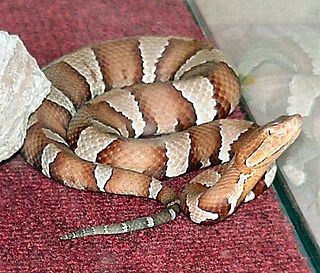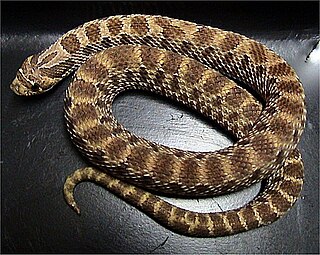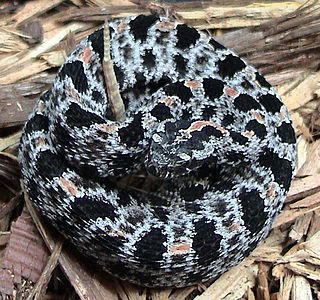
The eastern copperhead also as the copperhead is a species of venomous snake, a pit viper, endemic to Eastern North America; it is a member of the subfamily Crotalinae in the family Viperidae.it's generic name is derived from the Greek words ancistro (hooked) and odon (tooth), or fishhook. The trivial name, or specific epithet, comes from the Latin contortus ; which is usually interpreted to reference the distorted pattern of darker bands across the snake's back, which are broad at the lateral base but "pinched" into narrow hourglass shapes in the middle at the vertebral area. Five subspecies have been recognized in the past, but recent genetic analysis shows that A c. contorix and two of the subspecies are monotypic, while Agkistrodon laticinctus and the fifth subspecies are a single distinct species.

Agkistrodon piscivorus is a species of pit viper in the subfamily Crotalinae of the family Viperidae. It is the world's only semiaquatic viper, and is native to the southeastern United States. It is the one of 21 venomous snake species in the United States. As an adult, it is large and capable of delivering a painful and potentially fatal bite. When threatened, it may respond by coiling its body and displaying its fangs. Individuals may bite when feeling threatened or being handled in any way. It occurs in or near water, particularly in slow-moving and shallow lakes, streams, and marshes. It is a strong swimmer and has even been seen swimming in the ocean. However, it is not fully marine, unlike true sea snakes. It has successfully colonized islands off both the Atlantic and Gulf coasts.

Agkistrodon is a genus of pit vipers commonly known as American moccasins. The genus is endemic to North America, ranging from the Southern United States to northern Costa Rica. Eight species are currently recognized, all of them monotypic and closely related. Like all pit vipers, members of the genus are venomous. Common names include: cottonmouths, copperheads, and cantils.

Gloydius is a genus of venomous pitvipers endemic to Asia, also known as Asian moccasins or Asian ground pit vipers. Named after American herpetologist Howard K. Gloyd, this genus is very similar to the North American genus Agkistrodon. 22 species are currently recognized.

Nerodia is a genus of nonvenomous colubrid snakes commonly referred to as water snakes due to their aquatic behavior. The genus includes nine species, all native to North America.

Agkistrodon taylori, cammonly called Taylor's cantil is a venomous pitviper species found only in northeastern Mexico. It is named in honor of American herpetologist Edward Harrison Taylor.

Nerodia rhombifer, commonly known as the diamondback water snake, is a species of nonvenomous natricine colubrid endemic to the central United States and northern Mexico. There are three recognized subspecies of N. rhombifer, including the nominotypical subspecies.
Roger Conant was an American herpetologist, author, educator and conservationist. He was Director Emeritus of the Philadelphia Zoo and adjunct professor at the University of New Mexico. He wrote one of the first comprehensive field guides for North American reptiles in 1958 entitled: A Field Guide to Reptiles and Amphibians of Eastern and Central North America, in the Peterson Field Guide series.

Agkistrodon bilineatus is a highly venomous pit viper species found in Mexico and Central America as far south as Honduras.

Agkistrodon piscivorus conanti, commonly known as the Florida cottonmouth or green-tailed moccasin, is a pitviper subspecies of Agkistrodon piscivorus in the family Viperidae. The subspecies is found in the southeastern United States, particularly in Florida. Like all pitvipers, it is venomous.

Agkistrodon contortrix pictigaster is a venomous pit viper subspecies found in the Trans-Pecos region of the United States in western Texas, and northeastern Mexico.

Agkistrodon laticinctus is a venomous pit viper species, formerly considered a subspecies of Agkistrodon contortrix, which is found in the southern United States, from Kansas, through Oklahoma and throughout central Texas.

The western hognose snake is a species of nonvenomous snake in the family Colubridae. The species is endemic to North America.
Howard Kay Gloyd was an American herpetologist who is credited with describing several new species and subspecies of reptiles, such as the Florida cottonmouth, Agkistrodon piscivorus conanti.

Sistrurus miliarius streckeri is a venomous pit viper subspecies found in the southcentral United States.

Agkistrodon piscivorus piscivorus is a venomous pitviper, one of three subspecies of Agkistrodon piscivorus, with different geographic distributions, found in the southeastern United States.

Agkistrodon contortrix mokasen is a venomous pit viper subspecies found in the eastern United States.
Agkistrodon howardgloydi is a species of pit viper, a venomous snake in the subfamily Crotalinae in the family Viperidae. The subspecies is endemic to Central America.
Agkistrodon russeolus, commonly called the Yucatecan cantil, is a venomous pit viper species endemic to the Yucatán Peninsula in Mexico and northern Belize.
Hypnale walli, or Wall's hump-nosed viper, is a venomous pitviper species endemic to Sri Lanka. The smallest member of its genus, it is distinguished by having a strongly upturned nose and lower scale counts. No subspecies are currently recognized.















